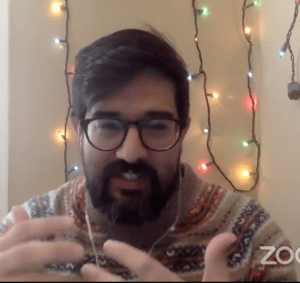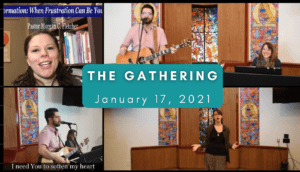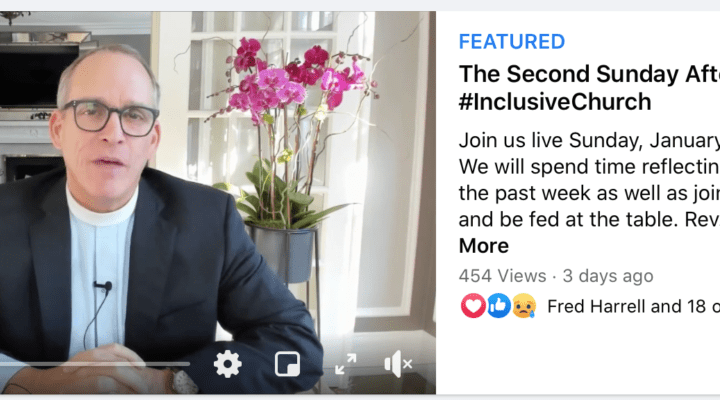As the COVID-19 pandemic approaches the one-year mark, churches continue to grapple with when — and how — to reopen for in-person worship and other activities. Some already have reopened, albeit with restrictions such as masks and social distancing in place. Others are taking a more cautious approach, vowing to reopen only when it’s safe for all.
Such is the case with City Church in San Francisco, where Fred Harrell is senior pastor.

Fred Harrell
“Rather than looking for some date, we are values-driven about when and how we will resume in-person gatherings,” Harrell said. “That includes data and guidance from scientists, and we are also driven by the value of inclusivity. We are reticent to pick and choose who can participate: Until larger gatherings are permitted, we can’t imagine getting together.”
Underpinning this philosophy is a commitment to follow the science, Harrell said, noting that his congregation includes the city’s deputy of public health as well as a leading virologist.
“We are lucky because we have fantastic scientists who are also Jesus followers,” Harrell said. “I don’t ever have to tell congregants to wear a mask — they do that willingly.”
Obeying the Second Commandment
Harrell said a love of neighbor is another factor in City Church’s decision to delay reopening until it’s safe for all. Brent Newberry, pastor of First Baptist Church of Worcester, Mass., said his church holds a similar view.
“I’m a pastor, not a scientist,” he said. “I have to take the information I have and filter it through the lens of theology. How do our actions match our mission? Are our actions matching our identity and our mission to love our neighbor?”

Brent Newberry preaching to the First Baptist congregation online last Sunday.
Ultimately, Newberry said, “we need to do our best so that the space is safe for all of our neighbors, especially those who are most at risk.”
Anne Jernberg Scalfaro, senior pastor of Calvary Baptist Church in Denver, agrees.
“We have decided it’s not worth the risk,” Scalfaro said. “Early on, we lost members of our congregation to COVID, and others in our church have had it. We have felt the impact personally and don’t see a need to come back until it’s safe.”
Calvary’s council, or governing board, is mindful not only of what’s right for the congregation, but also what’s right for the community.
“By remaining closed, we allow schools to reopen faster and businesses to remain open,” Scalfaro said. “That’s been an ethical guideline for us.”
That has been a factor for Newberry’s church, as well.
“We have the space to do services,” he said, “but we want to lead in the community at large to say, ‘This matters to us, and we will sacrifice our own desire to meet together to care for our city.’” Newberry added that he’s mindful of being a good example for younger generations.
“What are we teaching our youth by our actions?,” he said. “Are we teaching them it’s business as usual or that it’s something bigger than ourselves? We have to love our neighbors, and that means we have to sacrifice a little bit in this moment.”
A rapid pivot
The necessity to close, and stay closed, has forced churches like these to greatly expand their technological capabilities — or build them from scratch.
“In two weeks’ time, we were on Facebook, YouTube and Twitch.”
“We did zero virtual stuff before,” Harrell said. “We bought cameras, but we hadn’t used them. In two weeks’ time, we were on Facebook, YouTube and Twitch.”
Newberry has had a similar experience.
“Prior to the pandemic, we streamed our service with audio only, and it was linked to our website,” he said. As the church remained closed, “we have had a crash course on how you Zoom and how you do Facebook Live,” he said. “To add two or three more elements was a lot.” Even so, Newberry said, his congregation has adjusted well to the virtual environment.
“From the beginning, people felt it was the right thing to do, and for those who may not have been tech-savvy, they took tutorials or had family or friends helping,” Newberry explained.

Ann Jernberg Scalfaro
Scalfaro also has been pleased with her congregation’s willingness to adapt, not only to online worship but also to virtual events such as vacation Bible school and a virtual Christmas pageant.
“As hard as this time has been and as exhausting as it’s been, there’s a creativity we feel,” Scalfaro said. “We’re trying to reinvent ourselves — to strip away what was tried and true and embrace this new way of being. We’ve learned that we can still have community.”
Unexpected silver linings
The inability to meet in person has opened some pastors’ eyes to the benefits of virtual church. Holding services online allows churches to widen their reach, not only to many more people but also to different geographic locations.
“So many people have connected with us online,” Scalfaro said. “We’ve had them participate as a reader or as a musician in our service. A video submitted from Denver is the same as a video submitted from across the United States.”
In Massachusetts, Newberry has had a similar experience.
“We’ve lost some people just because it’s the pandemic and they don’t have the bandwidth for more online stuff or it’s just not the same,” he said. “But I don’t think they’re lost for good.”
At the same time, virtual events have allowed some members to stay connected when they otherwise wouldn’t be.
“We’ve had several members who moved away over the years who now have been able to stay a part of us over Zoom,” Newberry said. “They can do it from Tennessee or Georgia or Kentucky. We also have new members join who found us online and have been attending Bible studies and starting young adult game nights.”
In San Francisco, virtual events mean people don’t have to feel rushed trying to make it to a committee meeting after work.
For Harrell, in San Francisco, virtual events mean people don’t have to feel rushed trying to make it to a committee meeting after work. Now, members can just turn on their computers from the comfort of home. At City Church, that convenience has meant two to three times as many people attend classes, Harrell said, and it opens the church to people who otherwise don’t feel welcome inside the church building.
“They may not ever walk in on Sunday, but they can turn on the computer,” he said. “They still love Jesus even though the church has largely failed them.”
Looking ahead
Going forward, Harrell predicts churches will need to embrace virtual services and events long after COVID is over.
“Every church is going to have to be online and in-person from here on out,” he said, adding that some churches may even offer a membership category for online-only members.
More broadly, “the question in 2021 is, will we do the hard work of learning what we can learn from this, instead of just hating it and wishing we can all be back together?” Harrell said. “And what does our church look like now post-COVID — what is the new iteration of this community?”

Online worship from Calvary Baptist in Denver.
“As pastors, we love having people in the pews, but I don’t think that will disappear,” Scalfaro said. “The people who want to be there will be there. But we have to be able to engage in other ways.”
“Somehow the church has to figure out how to be virtual and still be committed to the incarnational skin on skin,” Harrell said. “I think we need to shift from skin on skin to life on life. What we have found is that the intersecting of lives through Zoom and other ways has been extremely effective in helping people.”
For her part, Scalfaro is up to the challenge.
“Before COVID, we were crafting worship as an experience for those in the room,” Scalfaro said. “And now we have created worship to be in the home, knowing that that’s where people are watching it.
“We see it as expansive,” she said. “It’s not limiting in-person gatherings; it’s providing another opportunity for people to connect.”
Still, Scalfaro can’t help but look forward to the day when COVID is a thing of the past. Vaccinations hold promise, but she knows the immunization process will take time.
“We want to be able to open without having to screen people,” Scalfaro said. “We know we can’t require people to get the vaccine, and we haven’t broached that question yet. And even though we have people who are beginning to get vaccinated, that process takes a month.”
Newberry agrees that vaccinations are the key to reopening safely — and he seems willing to wait.
“When I think about what it looks like to reopen,” he said, “our hope is to wait until everyone can come back, and the vaccines make that more possible. If we can hold on, then when we do come back, I’m hopeful there will be that energy to reconnect and remain open to the possibilities that weren’t there before.”
Helen Jerman is a professional writer and editor in Dallas. She earned a bachelor’s degree in journalism from Baylor University and now works in corporate communications.
Related articles:
Hybrid church is probably here to stay, but some things don’t translate well to digital
Pandemic opens the door to a far-flung notion of church membership
Congregations on mission and online doing better financially amid COVID


